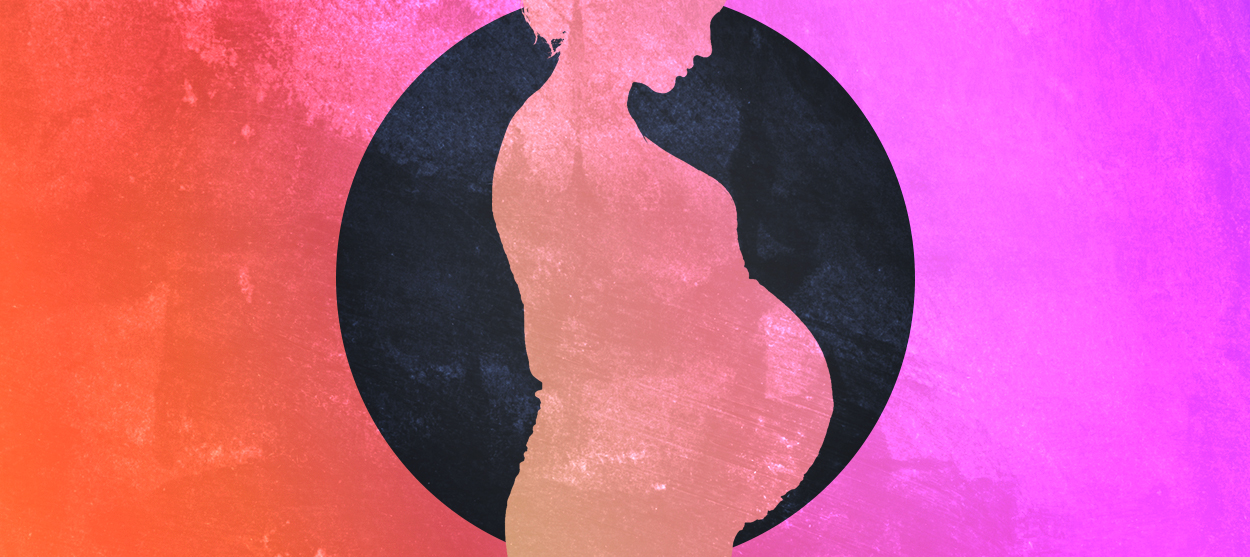A painful postpartum injury is plaguing America's moms — but nobody really talks about it
The "mommy pooch" isn't stomach fat. It's your vital organs.


When I learned I was having twins, I knew I was in for a physically difficult pregnancy.
In some ways, I got off easy: I had morning sickness, but it was mild enough that I only vomited once. My legs and feet swelled, but never enough to keep me from wearing my usual shoes.
However, I am a short person with a short torso which did not really have room for two babies plus their respective intrauterine accessories. By 20 weeks, I was pregnant and pathetic enough to persuade an airline clerk to bend company policy and offer me a free hotel room when my plane was delayed. Where some mothers delight in their babies' kicks, I groaned. It hurt! From around 32 weeks onward, my lungs were so crowded I'd sometimes run out of breath before the end of a sentence.
The Week
Escape your echo chamber. Get the facts behind the news, plus analysis from multiple perspectives.

Sign up for The Week's Free Newsletters
From our morning news briefing to a weekly Good News Newsletter, get the best of The Week delivered directly to your inbox.
From our morning news briefing to a weekly Good News Newsletter, get the best of The Week delivered directly to your inbox.
The delivery, after all that, came as something of a relief. I knew there would be a few months of recovery to follow, but I expected to go back to normal after that. Aside from the second baby, my pregnancy had been nearly free of complications. I was pronounced healthy at my six-week postpartum check-up and cleared to resume exercise. So I was surprised and dismayed to find, seven months after my twins were born, that my stomach was as big as it was at five months pregnant, exactly a year prior, when I won the pity of the airline clerk.
In retrospect, the real tip-off that something was wrong with my recovery was function, not form. Half a year after giving birth, I couldn't sit up from lying down. Sometimes I forgot this. I'd anticipate sitting up, and then ... nothing would happen. It was as if my brain sent a letter to my abdomen, and it got lost in the post. I could get upright by rolling to my side and pushing myself up with my arms, but this method was risky, too: About one time in 10 I'd have sudden, intense pain deep in the muscles around my hips that would only pass once I was finally upright.
My problem, as I suspected and a physical therapist who specializes in postpartum treatment confirmed, is a condition called diastasis recti.
During pregnancy, the uterus grows to about six times its size, approximating a watermelon by full term. This transformation happens inside the core cavity, bounded by four sets of muscles. Diastasis recti is the injury to the muscles and connective tissues at the front of the core cavity. This doesn't primarily mean the rectus abdominis, the "six-pack muscles." Those run (and thus stretch) vertically. But below them is a layer called the transverse abdominals, sheets of muscles that span more horizontally. And down the middle, connecting both muscle layers and running from the sternum to the pubic bone, is the linea alba, a white, fibrous connective tissue.
A free daily email with the biggest news stories of the day – and the best features from TheWeek.com
Normally, the linea alba is around an inch wide (or about two finger widths, as it's commonly measured by therapists). If you have diastasis recti, however, the tissue is pulled apart, and the gap can be as much as 10 finger widths (about five inches) while feeling deep and unsettlingly squishy and vulnerable. Typically combined with weak, overlax abdominal muscles, the visual result is what some call "mommy pooch" or "mum tum." Weight loss won't help, because the bulge isn't fat (though that may be there, too). It's your vital organs.
Were the pooch its only symptom, diastasis recti might be fairly grouped with stretch marks as an unwanted but harmless consequence of pregnancy. But the pooch is not the only symptom.
People with diastasis recti describe experiences of chronic back pain and difficulty "lift[ing] objects or do[ing] other routine daily activities," explains the Mayo Clinic. It can be implicated in more serious problems including "pelvic organ prolapse (when organs drop into the vagina), urinary and fecal incontinence, loss of stability, breathing and digestive problems, pelvic girdle pain," and sexual dysfunction. Many of these issues also involve damage to the pelvic floor, the bottom "hammock" of the core cavity. This type of injury is less visible than diastasis recti, but these muscles are crucial for maintaining continence, bowel function, and normal physical movement.
This dysfunction is extremely common in the United States. About one in three American mothers has diastasis recti that persists more than year after birth. The same proportion has at least one pelvic floor disorder like incontinence or prolapse, and two-thirds of those in the first group are in the second group, too. There are about 123 million adult women in America, of whom around 106 million (86 percent) have given birth.
That means tens of millions of American women are constantly, quietly living with these injuries.
Many physical therapists and trainers who work with people suffering from these symptoms insist on distinguishing between "common" and "normal." It is common to have a mommy pooch, to pee yourself when you laugh or run or wait 10 seconds too long to go to the bathroom. It is common, postpartum, for your organs to hang through overextended muscles. It is common to be in frequent pain, unable to comfortably lift your kid or hop up off your bed. Browse a mommy forum or mom influencer's comments section on Instagram and you'll find these symptoms are seen as an inevitable price of motherhood, like a mundane version of fairytale bargains where an evil witch makes suffering the price of fertility.
This is all very common. But it is absolutely not normal. This is not how our bodies are supposed to be.
"The truth of the matter is function is possible," Ashley Nowe, a pregnancy and postpartum corrective exercise specialist, told me. "You don't have to pee your pants when you jump or sneeze. You don't have to deal with painful sex. You don't have to settle for a dysfunctional core and back pain."
Nowe, like me, is a mother of twins. She too was cleared for exercise at six weeks, but by five months postpartum was wondering why it looked like there was a "football popping out of [her] stomach" during sit-ups. The answer was diastasis recti — the "football" was her linea alba under strain of inappropriate ab exercise — and her doctor told her she'd simply have to live with it because "there is nothing that can be done."
A pelvic floor therapist said otherwise. "I had to start with the very basics. Here I was, an athlete all my life, and I was having to learn to breathe properly," Nowe said of her therapy, which lasted a full year. It would be two more years after that before her diastasis recti, originally a deep gap of four finger widths, had improved enough for her to feel and function normally.
About a year post-therapy, Nowe realized how common her experience was and began taking classes and earning certifications to help other women similarly improve their quality of life. That primarily means teaching reparative exercises, but Nowe also educates her large following about available therapies and even discusses surgery as an avenue some women ultimately pursue.
Between fatigue, bronchitis, and sheer unwieldiness, I exercised relatively little while pregnant. But, in a moment of unjustified first-trimester ambition, I started following a few fitness trainers on Instagram who specialized in safe workouts for pregnant and postpartum women. Nowe was among them, so when I finally admitted to myself that I was not recovering normally, I had the vocabulary to understand what was happening to me and what I needed to do to address it.
Many women aren't so lucky, lulled into thinking what's common is normal — and permanent. Their postpartum injuries are too often ignored, normalized, or labeled a superficial "cosmetic" issue by the very providers they turn to for help.
Anecdotally, I've seen a marked rise in awareness of therapy options and exercise guidance like Nowe provides since I started reading parenting and pregnancy sites in 2017. These days, for every five "haha I pee myself all the time!" comments, there's usually at least one suggesting a pelvic floor therapist. But prenatal classes tend to focus on infant care, breastfeeding, and the early postpartum period, perhaps not wishing to scare new moms with tales of potential long-term struggles. I don't think any of the classes I took (at a super crunchy birth center!) mentioned diastasis recti or pelvic floor damage. Some doctors, like Nowe's, never check for postpartum core injuries or tell patients they're fixable.
The problem may be attributable in part to medical workers' knowledge gaps. "Education in gynecology and obstetrics is woefully inadequate in addressing musculoskeletal dysfunction, even of the pelvic floor in relation to pregnancy and postpartum," Dr. Amy Benjamin, a gynecologist who directs the University of Rochester's Center for Chronic Pelvic Pain and Vulvar Disorders, told The New York Times this year. But some of it may have to do with insurance coverage and what's considered "standard" care.
In several nations in Europe, postpartum physical therapy for core health is standard. In Germany, it's rückbildungsgymnastik, or "recovery gymnastics." In France, it's la rééducation périnéale, which is pelvic floor therapy but translates directly to the rather more evocative "perineal re-education." The U.K. doesn't have a comparable program but does advise teaching pelvic floor exercises to new moms suffering incontinence.
Here the States, postpartum therapy isn't standard — not even close. Depending on the policy and diagnosis, major insurers may cover some portion of this care if you have a doctor who diagnoses you or agrees to your request for therapy referral. My insurer got me a discount when I saw a therapist, but I still paid around $1,000 for six visits. That was steep for me, and it would be utterly inaccessible for many women. Exercise programs like Nowe's are more affordable, and trainers like her post free content on Instagram as well. But for someone with severe dysfunction, DIYing it isn't always enough.
The last-ditch option is surgery, but whether it's covered varies by condition. Surgery required to correct pelvic organ prolapse, for example, likely will be covered. By contrast, the minority of women with diastasis recti who can't get back to normal without surgery will get no help from their insurer. They'll pay out of pocket to the tune of $4,000 to $12,000, because insurance companies consider surgical diastasis recti repair "a cosmetic procedure," in the words of United Healthcare, which instead recommends "reassurance of the patient and family about the innocuous nature of this condition" as the "[a]ppropriate treatment."
I reached out to several large insurers whose coverage guidelines are publicly available online to inquire about the rationale for their coverage choices here. HealthPartners and Cigna declined to comment. United noted their coverage aligns with recommendations from American College of Obstetricians and Gynecologists, and Blue Cross Blue Shield of Minnesota said their policy is "consistent with that of Medicare and most other payers of health care."
That's true. The companies I contacted aren't outside the industry standard. They're not giving their customers worse service than their competitors provide. But that standard itself is wrong.
Consider that when breast cancer patients need reconstruction after a lumpectomy or mastectomy, that's typically covered by these four companies and industry-wide (this coverage has been mandated by federal law since 1998). But if you have a baby, and muscles essential to the function of the core part of your body get pulled apart and won't go back together with other care, a reparative abdominoplasty (commonly called a "tummy tuck") is "cosmetic." What?
I'm not saying breast reconstruction shouldn't be covered. But having one's organs sagging through damaged connective tissue — and experiencing the chronic pain, incontinence, or other symptoms likely involved in a case severe enough to warrant surgery — seems at least as significant a medical concern as changes to breast appearance. And if surgical correction for the worst cases of diastasis recti is deemed an unnecessary vanity, what does that say about medical providers' responsibility to notice, treat, and educate patients with milder cases?
My own case probably isn't serious enough for surgery, though I have browsed before and after photos on local plastic surgeons' sites, debating whether I could save up and whether the pain and risk would be worth it if I did. The physical therapy helped a lot — I can sit up almost normally now, and I don't get those sharp pains anymore. But my abdominal muscles are weak and always a bit sore, even if I haven't exercised them recently. It doesn't feel right when my twins sit on my stomach, and the bulge, though improved, isn't gone. I'd probably be further along were I as consistent in my daily exercises as I am about staring in the full-length mirror before bed and whining to my husband about lost youth.
As much as I complain, however, I'm also grateful my core injuries weren't worse. I can laugh and go for a run without worrying about incontinence, and I was able to get the therapeutic care I needed. But I'm disturbed by how this aspect of pregnancy and childbirth is handled in our country. There are millions of American women who have accepted needless, correctable dysfunction, weakness, and pain as a fact of life.
If these injuries are so common, why don't we talk about them more? Why isn't every new mother given the information she needs to prepare for this possibility and make a plan to protect and restore core health?
We need a better standard of care. Safe core training before and during pregnancy can help keep these injuries from happening in the first place, and proactive evaluation for diastasis recti and pelvic floor damage should be a routine part of postpartum care, along with referrals to exercise, therapy, or surgery as needed.
"The common narrative with motherhood is martyrdom, especially in today's day and age where women are supposed to do it all — take care of the kids, work full time, be on the PTA," Nowe said in our interview. But "with a little help and education, so many women can live with a better quality of life. You can feel like yourself again."
Want more essential commentary and analysis like this delivered straight to your inbox? Sign up for The Week's "Today's best articles" newsletter here.
Bonnie Kristian was a deputy editor and acting editor-in-chief of TheWeek.com. She is a columnist at Christianity Today and author of Untrustworthy: The Knowledge Crisis Breaking Our Brains, Polluting Our Politics, and Corrupting Christian Community (forthcoming 2022) and A Flexible Faith: Rethinking What It Means to Follow Jesus Today (2018). Her writing has also appeared at Time Magazine, CNN, USA Today, Newsweek, the Los Angeles Times, and The American Conservative, among other outlets.
-
 Russia’s ‘weird’ campaign to boost its birth rate
Russia’s ‘weird’ campaign to boost its birth rateUnder the Radar Demographic crisis spurs lawmakers to take increasingly desperate measures
-
 Could smaller cars bring down vehicle prices?
Could smaller cars bring down vehicle prices?Today’s Big Question Trump seems to think so, but experts aren’t so sure
-
 2025’s most notable new albums
2025’s most notable new albumsThe Week Recommends These were some of the finest releases of the past year
